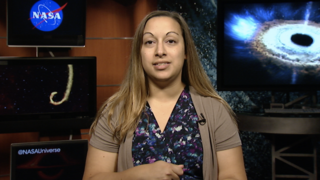Mysterious ‘Cow’ Blast Studied with NASA Telescopes
Watch what scientists think happens when a black hole tears apart a hot, dense white dwarf star. A team working with observations from NASA’s Neil Gehrels Swift Observatory suggest this process explains a mysterious outburst known as AT2018cow.
Credit: NASA's Goddard Space Flight Center
Music: "Curious Events" from Killer Tracks
Watch this video on the JPL YouTube channel.
Complete transcript available.
A brief and unusual flash spotted in the night sky on June 16, 2018, puzzled astronomers and astrophysicists across the globe. The event, called AT2018cow and nicknamed “the Cow” after the coincidental last letters of its official designation, is unlike any celestial outburst ever seen before, prompting multiple theories about its source.
Over three days, the Cow produced a sudden explosion of light at least 10 times brighter than a typical supernova, and then it faded over the next few months. This unusual event occurred near a star-forming galaxy known as CGCG 137-068, located about 200 million light-years away in the constellation Hercules.
Using data from multiple NASA missions, including the Neil Gehrels Swift Observatory and the Nuclear Spectroscopic Telescope Array (NuSTAR) and ESA’s (the European Space Agency's) XMM-Newton and INTEGRAL missions, two groups have provided possible explanations for the Cow’s origins. One group argues that the Cow is a monster black hole shredding a passing star. The second group hypothesizes that it is a supernova — a stellar explosion — that gave birth to a black hole or a neutron star. Whatever its source, the Cow represents a stellar death scenario not previously seen.
Labeled animation only, no intro text, audio, or end credits. Optimized for presentations.
Credit: NASA's Goddard Space Flight Center
An unlabeled, no-pause version of the above animation.
Credit: NASA's Goddard Space Flight Center
NASA’s Neil Gehrels Swift Observatory hosts three instruments that allow the satellite to observe ultraviolet, optical, X-ray and gamma-ray light.
Credit: NASA's Goddard Space Flight Center

AT2018cow erupted near a galaxy known as CGCG 137-068, which is located about 200 million light-years away in the constellation Hercules. The yellow cross shows the location of this puzzling outburst.
Credit: Sloan Digital Sky Survey

Same as above, no labels.
For More Information
Credits
Please give credit for this item to:
NASA's Goddard Space Flight Center. However, individual items should be credited as indicated above.
-
Producer
- Scott Wiessinger (USRA)
-
Science writer
- Jeanette Kazmierczak (University of Maryland College Park)
-
Animator
- Scott Wiessinger (USRA)
-
Scientist
- Amy Lien (UMBC)
Series
This page can be found in the following series:Release date
This page was originally published on Thursday, January 10, 2019.
This page was last updated on Wednesday, May 3, 2023 at 1:46 PM EDT.
